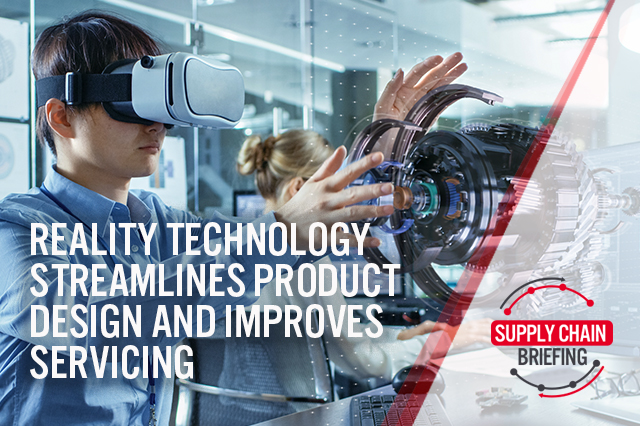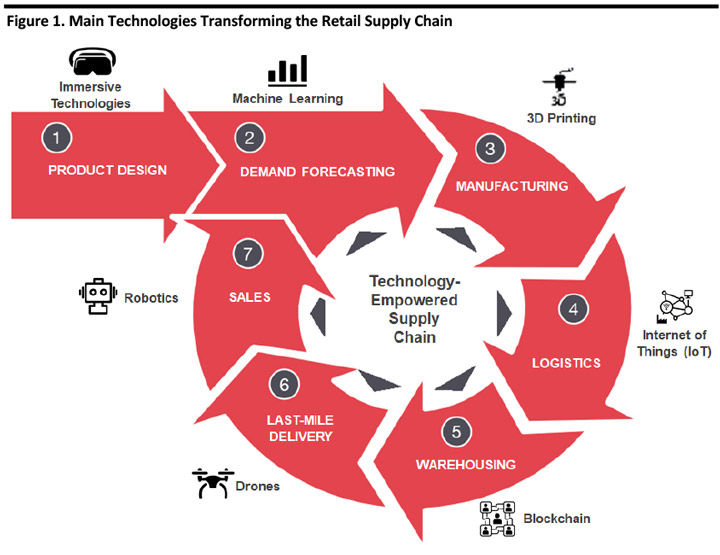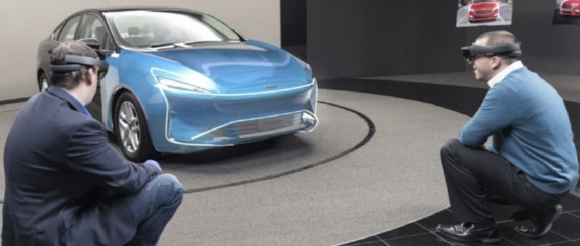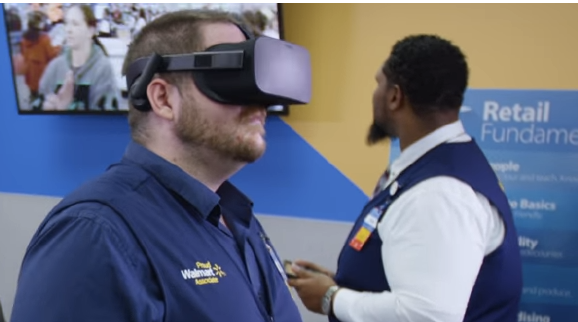
albert Chan
In our weekly series Supply Chain Briefing, we discuss how technology is transforming the various stages in the retail supply chain, including product design, demand forecasting, manufacturing, logistics, warehousing, last-mile delivery and sales.
Below, we illustrate the seven major components of a retail supply chain, and some of the technologies that can support processes at various stages – from product design to end consumer.
[caption id="attachment_88874" align="aligncenter" width="720"] Source: Coresight Research[/caption]
Reality technology digitally simulates or expands the user’s environment, and can be divided into three broad categories: AR, VR and mixed reality (MR). While AR combines computer graphics with real-world images, VR uses computer graphics to create an immersive environment that seems real. MR combines AR and VR by creating a VR environment of which physical objects are a part.
According to the 2018 Supply Chain Innovation Survey by Kenko, a supply chain management company, 23% companies plan to invest in AR and VR in 2018, compared with just 8% in 2017.
Below, we look at how companies are using reality technology to streamline various stages of the supply chain.
Reality Technology Helps Streamline Product Design
One of the major benefits of reality technology is speeding up product prototyping. Ford began using AR technology in 2017 to create 3D car models, eliminating the need to build every design prototype with clay. Using Microsoft’s MR headset HoloLens, Ford designers could stand in front of clay car models and see 3D vehicle elements overlaid onto them, making it faster to evaluate and modify design elements.
[caption id="attachment_89436" align="aligncenter" width="580"]
Source: Coresight Research[/caption]
Reality technology digitally simulates or expands the user’s environment, and can be divided into three broad categories: AR, VR and mixed reality (MR). While AR combines computer graphics with real-world images, VR uses computer graphics to create an immersive environment that seems real. MR combines AR and VR by creating a VR environment of which physical objects are a part.
According to the 2018 Supply Chain Innovation Survey by Kenko, a supply chain management company, 23% companies plan to invest in AR and VR in 2018, compared with just 8% in 2017.
Below, we look at how companies are using reality technology to streamline various stages of the supply chain.
Reality Technology Helps Streamline Product Design
One of the major benefits of reality technology is speeding up product prototyping. Ford began using AR technology in 2017 to create 3D car models, eliminating the need to build every design prototype with clay. Using Microsoft’s MR headset HoloLens, Ford designers could stand in front of clay car models and see 3D vehicle elements overlaid onto them, making it faster to evaluate and modify design elements.
[caption id="attachment_89436" align="aligncenter" width="580"] Microsoft's HoloLens AR headset for Ford
Microsoft's HoloLens AR headset for Ford
Source: Ford[/caption] Reality Technology Enables Quicker Production In March 2018, General Electric (GE) paired with software company Upskill to use VR for general maintenance. GE wind turbine workers can use VR to study turbine wiring techniques, delivering productivity improvements of almost 35% compared to learning without VR assistance. [caption id="attachment_89438" align="aligncenter" width="570"] General Electric’s VR training program
General Electric’s VR training program
Source: General Electric[/caption] Reality Technology Trains Staff to Deliver Better Service Apart from product design and production, reality technology can also help at the sales stage. In October 2018, Walmart rolled out a VR training program in collaboration with Oculus to train store staff in areas such as new technology, customer service and compliance. There are different activity-based modules available in the headset, where Walmart employees are exposed to different scenarios and simulations of interacting with customers and handling difficult situations. [caption id="attachment_89439" align="aligncenter" width="578"] Walmart’s VR training program for staff
Walmart’s VR training program for staff
Source: Walmart[/caption] Key Insights and Implications for Retailers Reality technology enables companies to streamline production through faster prototyping, to improve production speed and deliver better customer service in retail stores. Companies should recognize the benefits immersive technologies offer. We expect wider adoption of reality technology as the technology advances and becomes more accessible.
 Source: Coresight Research[/caption]
Reality technology digitally simulates or expands the user’s environment, and can be divided into three broad categories: AR, VR and mixed reality (MR). While AR combines computer graphics with real-world images, VR uses computer graphics to create an immersive environment that seems real. MR combines AR and VR by creating a VR environment of which physical objects are a part.
According to the 2018 Supply Chain Innovation Survey by Kenko, a supply chain management company, 23% companies plan to invest in AR and VR in 2018, compared with just 8% in 2017.
Below, we look at how companies are using reality technology to streamline various stages of the supply chain.
Reality Technology Helps Streamline Product Design
One of the major benefits of reality technology is speeding up product prototyping. Ford began using AR technology in 2017 to create 3D car models, eliminating the need to build every design prototype with clay. Using Microsoft’s MR headset HoloLens, Ford designers could stand in front of clay car models and see 3D vehicle elements overlaid onto them, making it faster to evaluate and modify design elements.
[caption id="attachment_89436" align="aligncenter" width="580"]
Source: Coresight Research[/caption]
Reality technology digitally simulates or expands the user’s environment, and can be divided into three broad categories: AR, VR and mixed reality (MR). While AR combines computer graphics with real-world images, VR uses computer graphics to create an immersive environment that seems real. MR combines AR and VR by creating a VR environment of which physical objects are a part.
According to the 2018 Supply Chain Innovation Survey by Kenko, a supply chain management company, 23% companies plan to invest in AR and VR in 2018, compared with just 8% in 2017.
Below, we look at how companies are using reality technology to streamline various stages of the supply chain.
Reality Technology Helps Streamline Product Design
One of the major benefits of reality technology is speeding up product prototyping. Ford began using AR technology in 2017 to create 3D car models, eliminating the need to build every design prototype with clay. Using Microsoft’s MR headset HoloLens, Ford designers could stand in front of clay car models and see 3D vehicle elements overlaid onto them, making it faster to evaluate and modify design elements.
[caption id="attachment_89436" align="aligncenter" width="580"] Microsoft's HoloLens AR headset for Ford
Microsoft's HoloLens AR headset for FordSource: Ford[/caption] Reality Technology Enables Quicker Production In March 2018, General Electric (GE) paired with software company Upskill to use VR for general maintenance. GE wind turbine workers can use VR to study turbine wiring techniques, delivering productivity improvements of almost 35% compared to learning without VR assistance. [caption id="attachment_89438" align="aligncenter" width="570"]
 General Electric’s VR training program
General Electric’s VR training programSource: General Electric[/caption] Reality Technology Trains Staff to Deliver Better Service Apart from product design and production, reality technology can also help at the sales stage. In October 2018, Walmart rolled out a VR training program in collaboration with Oculus to train store staff in areas such as new technology, customer service and compliance. There are different activity-based modules available in the headset, where Walmart employees are exposed to different scenarios and simulations of interacting with customers and handling difficult situations. [caption id="attachment_89439" align="aligncenter" width="578"]
 Walmart’s VR training program for staff
Walmart’s VR training program for staffSource: Walmart[/caption] Key Insights and Implications for Retailers Reality technology enables companies to streamline production through faster prototyping, to improve production speed and deliver better customer service in retail stores. Companies should recognize the benefits immersive technologies offer. We expect wider adoption of reality technology as the technology advances and becomes more accessible.